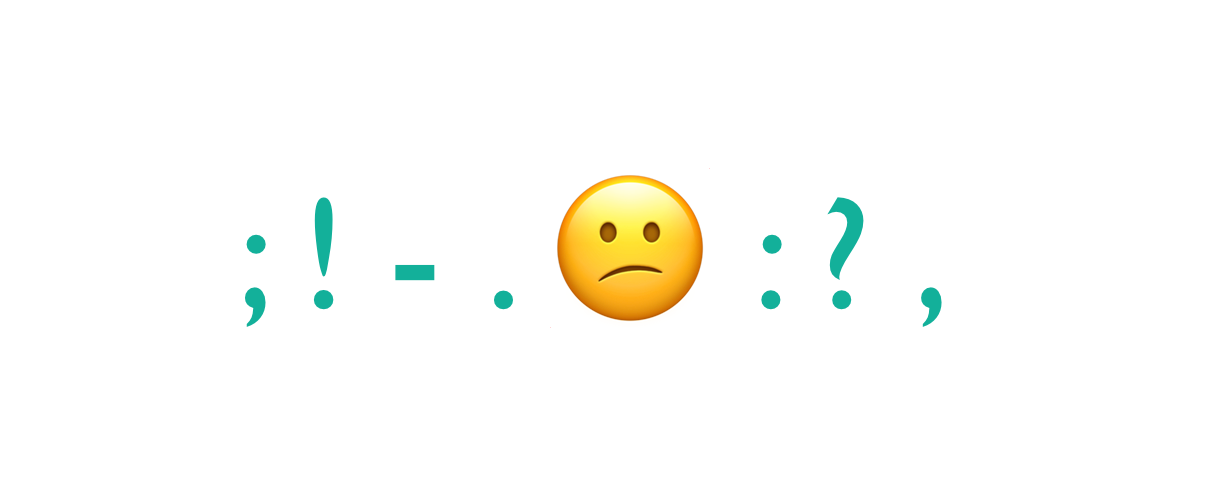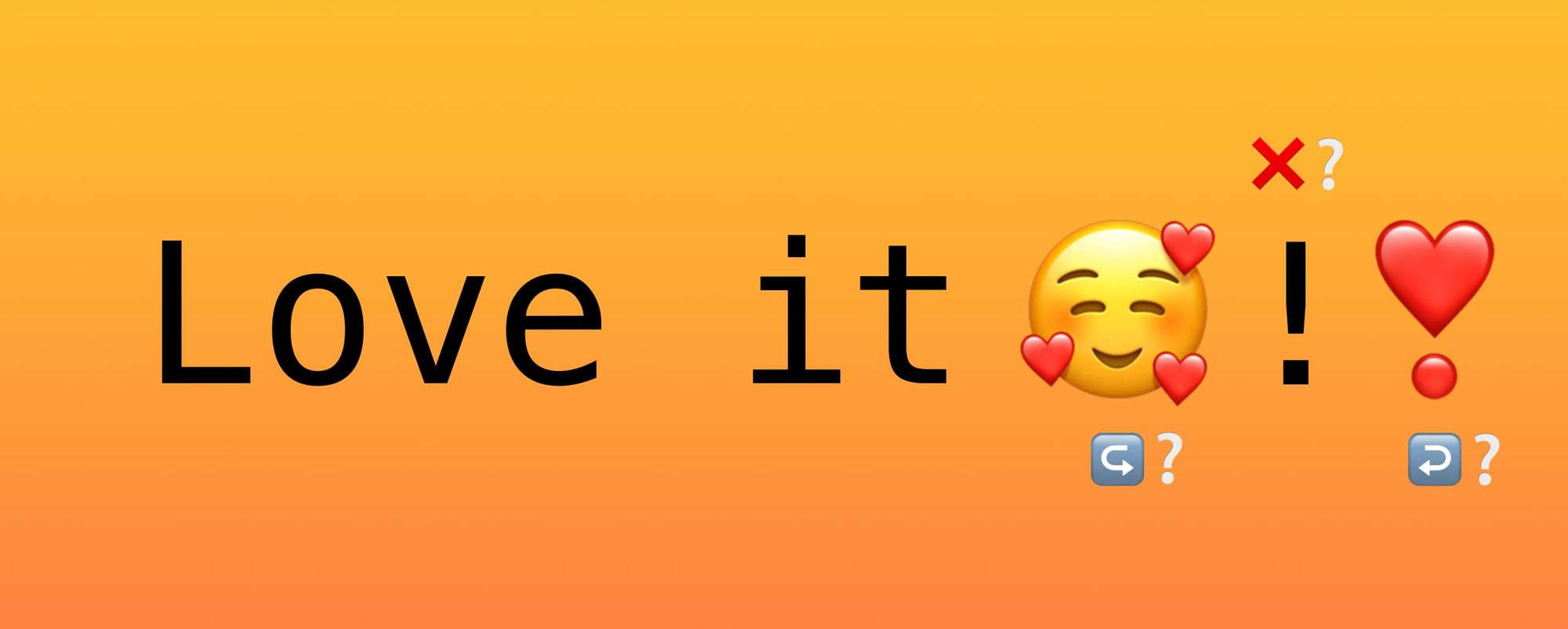The Definitive Guide to Emoji Punctuation

When it comes to emojis and punctuation, the rules are still up in the air. In absence of any formal conventions, emojis’ place alongside traditional punctuation often comes down to a rubric of subjective user intuition.
Additionally emojis are being used as punctuation in a variety of ways, sometimes to mimic actual punctuation marks, sometimes to echo a gesture, and sometimes to evoke shared cultural knowledge.

Emojis with Punctuation
Before diving into how emojis interact with existing punctuation, it’s important to establish that punctuation, like the language it frames, is a living, evolving thing.
Rules of punctuation are not always as fixed or straightforward as they might seem. Periods are perhaps the most basic punctuation mark and the first piece of punctuation a young child learns, but even their use has been in flux over the last decade.
In the realm of text messages and social media, the role of the period has been up for debate in recent years. In a text message, pressing “send” often indicates a stop in a thought, or at the very least, a physical pause in typing. For some people this makes periods obsolete in this informal context.
Linguist and emoji expert Tyler Schnoebelen has been studying online communication for over a decade. He explained that in addition to this act of pressing “send,” there’s also a visual cue to suggest the end of a transmission: “Text messages and tweets already have a terminus, which is just the fact that they exist in little ‘bubbles.’” For these reasons, when a period is used, it can sometimes feel angry. Thinkpieces on the passive-aggressive period have been coming out since as early as 2013.
Throwing emojis into the mix doesn’t simplify matters. If an emoji falls at the end of a sentence, do you need to use any terminal punctuation? Does the emoji act as enough of a visual stopping point, or is classic punctuation required? If you’re using quotation marks, does an emoji go inside or outside them?
Gretchen McCulloch asked these questions in a 2015 Mental Floss piece, so I won’t go into this in too much depth here. She concludes that it’s about personal style preference and avoiding a cluster of characters that look weird or might cause confusion.
As with the case of the dropped period in text messaging and social media posts where an “end of thought” is implied, including unnecessary punctuation can appear overly formal, and that can come across as stiffness or sometimes passive aggression.
You’re far more likely to see emojis used in short-form informal contexts where traditional punctuation conventions are playfully defenestrated in the name of creative expression than in formal contexts where punctuation rules are more standardized and revered.
What feels right, what feels wrong, what looks—for lack of a better word—dorky. These are important factors in the evolving conventions of how emojis interact with existing punctuation. As time passes, perhaps a set of rules will become understood by emoji users. Perhaps they will even become formalized. We’re not there yet.
Emojis as Punctuation
Emojis used as punctuation can be split up into two subgroups based on positioning around other non-emoji text: emojis surrounding and framing non-emoji text and emojis as terminal punctuation.
In the category of emojis as punctuation framing non-emoji text is the ✌️Victory Hand used on either side of a word or string of words as air quotes. The first time I noticed this was on writer and commentator Jemele Hill’s Twitter account.
Let’s all take a moment to appreciate @jemelehill’s ADVANCED emoji use. Never seen anyone else use ✌️ for air quotes before. pic.twitter.com/KWuk5VIEjJ
— 〰️Jane Solomon〰️ (@janesolomon) October 28, 2017
Hill could have used non-emoji quotation marks, but she didn’t. The choice to use emojis here is intentional. The inherently playful nature of emoji adds a layer of irony to her tweets. Her mocking tone and sense of humor shine through in this choice. You can feel her rolling her eyes when you read her tweets, and that might have been lost with your basic quotation marks. Additionally air quotes are functionally different than quotation marks because they represent a speech act combined with finger gesturing. Quotation marks in written text don’t tend to directly evoke the combination of someone physically speaking and gesturing in this way.
Related to the use of emojis as air quotes are emojis as emphasis. You see this when people surround words with attention grabbing emojis like 🚨 Police Car Light or ⚠️ Warning, or with pretty emojis like ✨ Sparkles or various flowers.
⚠️ Flash Flood Watch in Effect⚠️
🚨SALE🚨
I had the ✨best✨ time!!!
🌸Spring🌸 is here
It could be argued that this is more emojis as formatting than emojis as punctuation, but the lines are blurred. Air quotes, too, can be used for emphasis, as much as pedants hate this use. Growing up, my brother worked at a store called Pet Supplies “Plus,” and we always wondered what exactly the quotes were trying to tell us.
Finally, there’s emojis as terminal punctuation. It’s impossible to talk about this topic without mentioning Cher.
Any casual follower of Cher’s Twitter account might notice that she often ends sentences with emojis that directly correspond with traditional punctuation. ⁉️ Exclamation Question Mark and ‼️ Double Exclamation Mark are among her favorites.
Other traditional forms of punctuation which have direct emoji alternatives include ❗ Exclamation Mark, ❓ Question Mark, ❔ White Question Mark, and ❕ White Exclamation Mark. In the half-way ground, we have a heart that sits above a red circle to create an exclamation mark:❣️ Heart Exclamation.
Schnoebelen, who is more than a casual follower of Cher, has discussed her emoji use on Twitter in his piece Cher is the Queen of Emoji even if she isn’t. Schnoebelen explained that the “big and loud” way Cher uses emojis is a reflection of her personality:
“I think the big red emoji punctuation follow a kind of bold style that she's known for not just on Twitter but in her outfits and the general persona.”
He noted that “even before she started using emoji, Cher was using a lot of exclamation points and ALL CAPS,” so this attention-grabbing use of emojis as punctuation is in line with Cher’s overall style.
Another of Cher’s favorite ways to end thoughts on social media is with 💋 Kiss Mark. The following tweet ends with a kiss, but pay attention to the other emoji punctuation she uses too. Note that even Cher is not internally consistent in how her emojis interact with traditional punctuation. Sometimes she drops the traditional punctuation, and other times she preserves it.
WHEN I’M BEHIND THE CURTAIN,WATCHING MY ENTIRE LIFE GO BYE....17+-🙄 ,
— Cher (@cher) October 1, 2019
I WONDER,Hhmmm🤔,SHOULD I STILL BE DOING THIS⁉️
✨THEN CURTAIN DROPS✨,
I SEE YOUR EYES💫 & WE’RE
OFF ON OUR TRIP🚀. WE DANCE,SING,LAUGH TOGETHER LIKE LITTLE KIDS, TILL”BELIEVE”IS OVER & I BOW &DANCE OFF💋
The 💋 Kiss Mark in this final position nods to the real-world action of sealing a message with a kiss. While Cher uses the kiss as terminal punctuation in a very sincere way above, this sign off can sometimes carry a more snarky or sassy tone, similar to ending a message with 💅 Nail Polish or 💁 Person Tipping Hand.
Of course there are multiple ways to seal messages with kisses with emojis. Schnoebelen favors the smiley blowing a kiss. “I certainly do this—I very commonly end messages to boyfriends with 😘” he said.
In this same vein of emojis that operate as terminal punctuation is 🤔 Thinking Face. It can be used alongside a question mark to indicate skepticism, or even to replace a question mark, since it can make the question mark redundant.
If I organized a library card registration day would yall pull up 🤔
— Noname's Book Club (@NonameBooks) December 5, 2019
A unique perspective on cities! Take a look at John Harvey's model Cities in Sections: Going Underground!
— LEGO® IDEAS (@LEGOIdeas) December 5, 2019
Which city would you like to see in this style? 🤔
Take a look at today's Staff Pick here: https://t.co/bhb5N6Ns79 #LEGOIdeas pic.twitter.com/JueaBryGco
💫 Dizzy, which really looks more like a shooting star, can be used to end messages to evoke The More You Know, a popular meme based on a series of public service announcements aired in the US starting in 1989.
The meme iterations of The More You Know contain a fun fact (sometimes they are actually factual, but often not) and then end with a GIF from the public service announcement. As the meme became more and more popular, it was possible to leave off the gif and just use the shooting star emoji in its place to the same effect. Like 🤔 Thinking Face, this can be used to end a thought with or without traditional punctuation.
So I took an online quiz to see which faction I am. Almost equal parts but...1. Candor 2. Erudite 3. Dauntless. The more you know💫
— Johnny Weir (@JohnnyGWeir) January 17, 2017
The more you know! 💫 https://t.co/d9sAu4EM6T
— dan levy (@danjlevy) May 23, 2017
While these uses could be classified as terminal punctuation, there are other possible interpretations. Perhaps emojis are simply being used as tone markers in these contexts. “I think it's hard to disentangle tone and punctuation,” Schnoebelen said. “If you try to pull them apart it's something like punctuation is structuring and tone is expressing how the writer feels about the message and/or recipient.” It could simply be that emoji tone markers tend to come at the end of a thought in the exact same place where traditional punctuation would fall.
But there’s something very punctuation-like going on with these emojis that feels distinct from tone. Tone is a filter over the whole message, whereas these emojis hold a strong sense of “thought ending.”
“I think there's a lot to the hypothesis that one of the main ways of using emoji is to indicate a friendly way of saying ‘end transmission’ instead of just ending it,” Schnoebelen said. Emojis also give people, like Cher, a chance to show personality, emotion, and tone in a medium where it might otherwise be lost. Traditional punctuation can do this to some extent, and emojis can help further bridge that gap.
